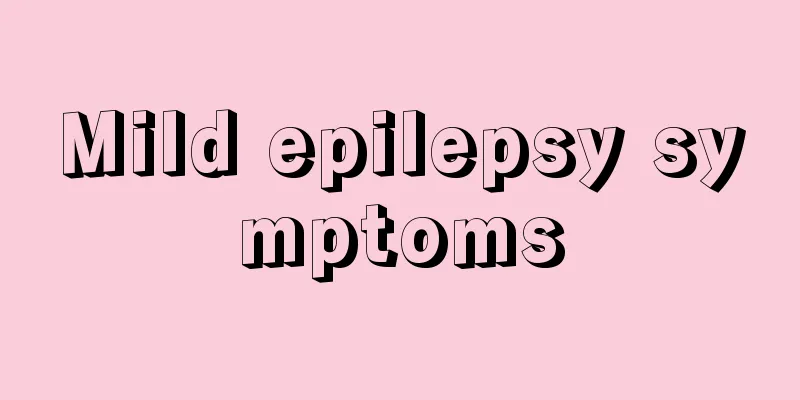Mild epilepsy symptoms

|
Epilepsy is a very common mental illness, and the frequency of epilepsy attacks has been increasing in recent years. Not only the elderly can suffer from epilepsy, many young people and even children have this disease. The onset time of epilepsy in patients is not fixed, and the manifestations are also completely different. Everyone needs to go to the hospital for treatment in time. So, what are the symptoms of mild epilepsy? 1. Epileptic nystagmus: nystagmus is the main or only symptom of epileptic seizures. Epileptic nystagmus is rare as a manifestation of focal epileptic seizures. The patient may have no history of epilepsy. Epileptic nystagmus may occur suddenly without any cause, or it may occur under certain specific factors, such as light stimulation, deep breathing, pressure on the eyeball, etc. The nystagmus is mostly horizontal, fast and opposite to the epileptic focus, and may be accompanied by horizontal gaze away from or toward the epileptic focus. During an attack, the patient may have blurred vision, which lasts for a short time. 2. Focal seizure: This is a localized seizure (starting in one part of the brain, or spreading to other parts, or being confined to that part). Symptoms range from mild to moderately severe, depending on which part of the brain is affected. Simple focal seizures cause convulsions and hallucinations but not loss of consciousness. 3. Whole body convulsions: Not necessarily caused by epilepsy. Let us understand it in more detail: Whole body convulsions triggered by temporary distress (such as high fever, brain infection or near drowning) are certainly not epilepsy; whole body convulsions caused by mental or psychological problems are not true epilepsy, and are medically called pseudo-epileptic seizures. Even a single whole-body convulsion for unknown reasons is not usually considered a sign of epilepsy unless it occurs repeatedly. 4. Special symptoms of postural epilepsy: refers to a form of epilepsy in which seizures occur repeatedly and are manifested mainly in certain posture patterns, often due to involvement of the supplementary motor area of the frontal lobe. The typical manifestation is a deviation of the head and eyes to one side accompanied by postural rigidity of one or more limbs. It is common to see the upper limb facing the side raised with the elbow semi-flexed, like fencing. At the same time, consciousness is mostly retained, and some patients scream or are unable to speak. The entire attack process lasts for a short time. This type of postural seizure is generally not accompanied by clonic movements, but can transform into other forms of seizures. 5. Special symptoms of rotational epilepsy: Rotational epilepsy is a special type of epilepsy, which is easily confused with torsion spasms and some other mental illnesses in clinical practice, leading to misdiagnosis. This disease is rare in clinical practice, with repeated rotational attacks as the main manifestation. An epileptic seizure may manifest as a simple sudden turning of the head and eyes to one side, mostly to the opposite side of the abnormal discharge. It may also be accompanied by rotation of the trunk, and the patient seems to be looking to the side or back. |
<<: What is the reason for pain after tooth filling
>>: Efficacy of natural garnet
Recommend
Hair loss again one year after hair transplant?
In modern society, people are under increasing wo...
Methods for routine examination of nasopharyngeal carcinoma
Nasopharyngeal cancer has become a disease of the...
What tests should be done for pituitary tumors
What tests should be done for pituitary tumors? T...
Does beer reduce fever?
There are many factors that cause a person to exp...
What to do if you have hip developmental delay?
Have you ever noticed that your baby’s legs are d...
Cellulite skin
As you age or your body fat continues to increase...
The best ointment for burn scars
In order to remove scars use scar ointment, we ha...
Several measures to prevent cervical cancer
Cervical cancer is a common disease in life. Afte...
Can honey and brown sugar remove spots?
We all know that the function of honey is to beau...
How long can you live with peritoneal metastasis of colon cancer
Colon cancer also has the characteristic of metas...
Itchy skin all over the body
The skin is very sensitive, and a small stimulati...
Will gastric cancer cause severe anemia?
In our lifetime, we will always encounter many di...
What to do if kidney stones cause excruciating pain
Once kidney stones are formed in the human kidney...
Why does eating betel nut cause chest tightness?
Chest tightness is a symptom that may be caused b...
What are the sequelae of lumbar spinal stenosis surgery
Humans are vertebrate creatures, which means that...









